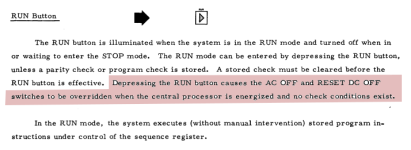durgadas311
Veteran Member
Great news about the front panel. Now you just need a computer!
As I was looking over some of those photos, I noticed that all have only 4 bits/buttons for the control register. But according to H200 programmer's guide, the variant character for LCR was already supporting more than 16 registers (mostly expansion for peripheral channels). The core CPU CRs (64, 66, 67, 70, 76, 77) seem to be non-conflicting with peripherals channels, so with a small enough complement of peripheral channels one would get by with only 4 bits. But I wonder if these machines (with 4-bit CR entry) either had a smaller number of peripheral channels or else the customers just got by without access to the additional channel registers from the front panel?
P.S.: I guess the "console typewriter" on 220-2/3 consoles eliminates the front panel and any dependency on a specific number of buttons (in any field). So, perhaps "larger" machines were just always configured with 220-2/3 consoles, and didn't depend on any mechanical expansion of buttons.
As I was looking over some of those photos, I noticed that all have only 4 bits/buttons for the control register. But according to H200 programmer's guide, the variant character for LCR was already supporting more than 16 registers (mostly expansion for peripheral channels). The core CPU CRs (64, 66, 67, 70, 76, 77) seem to be non-conflicting with peripherals channels, so with a small enough complement of peripheral channels one would get by with only 4 bits. But I wonder if these machines (with 4-bit CR entry) either had a smaller number of peripheral channels or else the customers just got by without access to the additional channel registers from the front panel?
P.S.: I guess the "console typewriter" on 220-2/3 consoles eliminates the front panel and any dependency on a specific number of buttons (in any field). So, perhaps "larger" machines were just always configured with 220-2/3 consoles, and didn't depend on any mechanical expansion of buttons.
Last edited:






